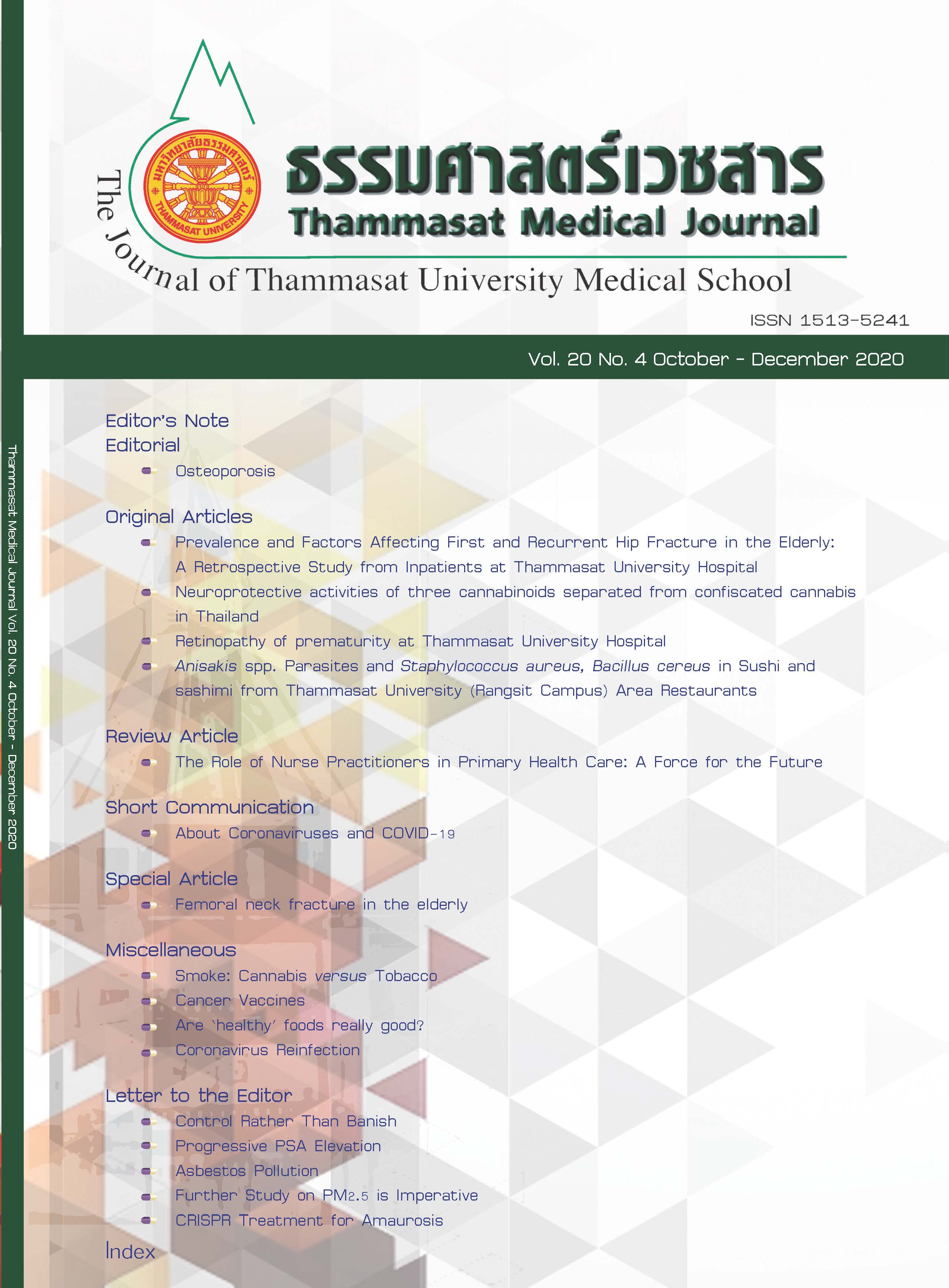Retinopathy of prematurity at Thammasat University Hospital
Keywords:
Retinopathy of prematurity, Prematurity, Birth weight, Gestational age, Risk factorAbstract
Background: Retinopathy of Prematurity (ROP) is one of the major causes of retinal vascular changes and subsequent abnormal vision in children. ROP has 5 stages of severity ranging from abnormal blood vessel growth to retinal detachment. The severity of ROP depends on the gestational age and lesion location.
Objective: To study factors related to ROP in preterm infants
Methods: This descriptive study comprised 100 preterm infants with criteria of gestational age at birth of less than 37 weeks or birth weight less than 2,000 grams and born from 1 January to 31
December 2017 in Thammasat University Hospital. The neonatal data and eye examination results were recorded and analyzed.
Results: ROP occurred in 10 percent of 100 premature infants, and 3 percent of patients were treated. The data analysis found that the risk factors associated with ROP included low birth weight,
prematurity, bronchopulmonary dysplasia, respiratory distress, and intraventricular hemorrhage which conferred significantly higher risk of ROP, while transient tachypnea of the newborn
conferred significantly lower risk.
Conclusion: Our study provides support to previous study regarding the risk factors of ROP. Furthermore, this study shows that transient tachypnea of the newborn could act as a protective factor against ROP.
References
2. Cryotherapy for Retinopathy of Prematurity Cooperative Group. Multicenter trial of cryotherapy for retinopathy of prematurity: natural history ROP:ocular outcome at 5(½) years in premature infants with birth weights less than 1251 g. Arch Ophthalmol. 2002;120(5):595-599.
3. Tanterdtam J, Leetiratanai V, NamatraC, et al. Retinopathy of prematurity. Thai J Ophtalmo. 1993;7:107-112.
4. Singha P, Tengtrisorn S, Chanvitan P. The incidence of Retinopathy of prematurity in premature infants with birth weight 2,000 g or less at Songklanagarind Hospital. Songkla Med J. 2008;26(4):377-383.
5. Lad EM, Hernandez-Boussard T, Morton JM, et al. Incidence of retinopathy of prematurity in the United States: 1997 through 2005. Am J Ophthalmol. 2009 Sep;148(3):451-458.
6. Adams GGW, Bunce C, Xing W, et al.Treatment trends for retinopathy of prematurity in the UK: active surveillance study of infants at risk. BMJ Open. 2017; 7:013366.
7. Good WV, Hardy RJ, Dobson V, et al. The incidence and course of retinopathy of prematurity Cooperative Group. Pediatrics. 2005;116:115.
8. Hussain N, Clive J, Bhandari V. Current incidence of retinopathy of prematurity, 1989-1997. Pediatrics. 1999;104:e26.
9. Ying GS, Quinn GE, Wade KC, et al. Predictors for the development of referral-warranted retinopathy of prematurity in the telemedicine approaches to evaluating acute-phase retinopathy
prematurity (e-ROP) study. JAMA Ophthalmol. 2015 Mar;133(3):304-311.
10. Darlow BA, Hutchinson JL, Henderson-Smart DJ, et al. Prenatal risk factors for severe retinopathy of prematurity among very preterm infants of the Australian and New Zealand Neonatal Network. Pediatrics. 2005;115:990.
11. Seiberth V, Linderkamp O. Risk factors in retinopathy of prematurity. A multivariate statistical analysis. Ophthalmologica. 2000;214(2):131-135.
12. Askie LM. Optimal oxygen saturations in preterm infants: A moving target. Curr Opin Pediatr. 2013;25:188-192.
13. SUPPORT Study Group for the Eunice Kennedy Shriver NICHD Neonatal Research Network. Target ranges of oxygen saturation in extremely preterm infants. N Engl J Med. 2010;362:1959-1969.
14. Boost II United Kingdom, Australia and New Zealand Collaborative Groups. Oxygen saturation and outcomes in preterm infants. N Engl J Med. 2013;368:2094-104.
15. Schmidt B, Whyte RK, Asztalos EV,et al. Effects of targeting higher vs. lower arterial oxygen saturations on death or disability in extremely preterm infants: a randomized clinical trial. JAMA.
013;309:2111-2120.
16. The Stop-ROP Multicenter Study Group. Supplemental Therapeutic Oxygen for Prethreshold Retinopathy of Prematurity (STOP-ROP), a randomized, controlled trial. I: primary outcomes. Pediatrics. 2000;105:295-310.
17. McGregor ML, Bremer DL, Cole C, et al. Retinopathy of prematurity outcome in infants with prethreshold retinopathy of prematurity and oxygen saturation >94% in room air: the high oxygen percentage in retinopathy of prematurity study. Pediatrics. 2002;110:540–544.
18. Johanna MW, Sebastian B, Amelie P, et al.The German ROP Registry: data from 90 infants treated for retinopathy of prematurity. Acta Ophthalmologica. 2016 Dec;744-752.
19. Gerull R, Brauer V, BasslerD,et al.Incidence of retinopathy of prematurity (ROP) and ROP treatment in Switzerland 2006–2015: a population-based analysis Archives of Disease in Childhood-Fetal and Neonatal Edition. 2018;103:337-342.



